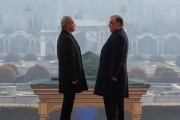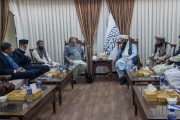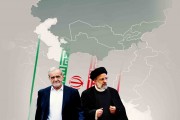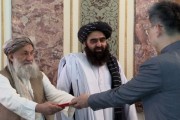Ambiguity in Pakistan-Saudi Arabia strategic relations
The Pakistan-Saudi Arabia relations, which have seemed to be strategic so far, are changing profoundly. This transformation has been intensified under the influence of the political and ideological rivalries in the region as well as the rivalry of global powers in the form of two eastern and western blocs under the leadership of China and Russia on one hand, and the US on the other. The main issue is grabbing the title of the 21th hegemonic power. These two blocs are trying to recruit more countries from all around the world. Based on these regional and global developments that have affected both the objective and subjective interactions of these two countries, the future of the Pakistan-Saudi Arabia relations will largely depend on the fate of the world powers’ rivalries.
By: Pir Mohammad Mollazehi
Pakistani Foreign Minister Shah Mahmood Qureshi recently expressed dissatisfaction with Saudi Arabia's refusal to support Pakistan's stance over Kashmir’s dispute and criticized the kingdom for not holding an urgent session of the Organization for Islamic Cooperation (OIC) regarding the issue. He also noted that Pakistan is considering other options. This may refer to Pakistan's decision for joining an alliance outside the OIC, which was previously proposed by Turkish President Recep Tayyip Erdogan. According to Erdogan’s plan, an alternative meeting could be held outside the influence of Saudi Arabia and with participation of Iran, Turkey, Malaysia, Pakistan and other Islamic countries, and with cooperation of China. Now, the main question is whether the era of Pakistan and Saudi Arabia’s strategic relations is over? If so, what are the reasons?
To better understand the upcoming developments, it is necessary to have a brief review of the two countries’ strategic relations over the past years. This relationship can be divided into two parts.
Objective and practical interactions
Economic cooperation at two different levels:
*Creating a labor market for the Pakistani citizens in Saudi Arabia and earning up to $5.4 billion a year; and
*Giving financial grants as well as loans with favorable terms
Mental and impractical interactions
*Saudi Arabia maintains that Pakistan's military and nuclear power would guarantee the survival of the Saudi monarchy and would be available when necessary. Pakistan's nuclear bomb is an Islamic bomb.
*Pakistan believes that Saudi Arabia is an ally that will support Islamabad’s stance in the face of India in any situation. In times of need, Saudi Arabia’s money and energy will also flow to Pakistan.
But, the truth is that the current regional and international developments are no more consistent with such one-sided mental perceptions. The most important of them can be summarized as follows:
Pakistani Foreign Minister Shah Mahmood Qureshi recently expressed dissatisfaction with Saudi Arabia's refusal to support Pakistan's stance over Kashmir’s dispute and criticized the kingdom for not holding an urgent session of the Organization for Islamic Cooperation (OIC) regarding the issue. He also noted that Pakistan is considering other options. This may refer to Pakistan's decision for joining an alliance outside the OIC, which was previously proposed by Turkish President Recep Tayyip Erdogan. According to Erdogan’s plan, an alternative meeting could be held outside the influence of Saudi Arabia and with participation of Iran, Turkey, Malaysia, Pakistan and other Islamic countries, and with cooperation of China. Now, the main question is whether the era of Pakistan and Saudi Arabia’s strategic relations is over? If so, what are the reasons?
To better understand the upcoming developments, it is necessary to have a brief review of the two countries’ strategic relations over the past years. This relationship can be divided into two parts.
Objective and practical interactions
Economic cooperation at two different levels:
*Creating a labor market for the Pakistani citizens in Saudi Arabia and earning up to $5.4 billion a year; and
*Giving financial grants as well as loans with favorable terms
Mental and impractical interactions
*Saudi Arabia maintains that Pakistan's military and nuclear power would guarantee the survival of the Saudi monarchy and would be available when necessary. Pakistan's nuclear bomb is an Islamic bomb.
*Pakistan believes that Saudi Arabia is an ally that will support Islamabad’s stance in the face of India in any situation. In times of need, Saudi Arabia’s money and energy will also flow to Pakistan.
But, the truth is that the current regional and international developments are no more consistent with such one-sided mental perceptions. The most important of them can be summarized as follows:
The regional developments
At the regional level, several important events have taken place that have had a decisive impact over the Saudi-Pakistan relations. The most important of them are:
1- The Yemen war
When Saudi Crown Prince Mohammad bin Salman announced a so-called Islamic coalition against Yemen, he mentioned Pakistan as an important part of the coalition without previously informing the country. He was apparently so delusional that he did not even feel the need for a one-on-one telephone consultation with Pakistan. The announcement created a serious tension between the army and the then Prime Minister Nawaz Sharif. The Pakistani officials felt that as if their independence has been ignored by Saudi Arabia. The Pakistan army was reluctant to get involved in such an endless war. Nawaz Sharif's government also had some political considerations regarding its powerful neighbor, Iran, despite the fact that Nawaz owed his life to the king of Saudi Arabia. In this situation, Pakistan's national interest was in neutrality and, of course, Islamabad could not accept the humiliating behavior of the Saudi officials.
Therefore, the middle ground was agreed upon by Nawaz Sharif and the army and government decided to hand over the decision to the country’s National Assembly. The scene was designed in such a way that the proposal was rejected in parliament and a legal escape route was found to reject Saudi Arabia's request. But, to appease the Saudi crown prince who was disillusioned by Pakistan's decision, it was announced that Gen. Raheel Sharif, the former Pakistan’s Chief of Army Staff, would take the command of the coalition. Although he was recently retired and was legally barred from holding any office for two years, in an emergency meeting, the Pakistan government and army made an exception in his case and circumvented the country’s law to satisfy Saudi Arabia.
2- Kashmir crisis
The right-wing government of India, led by Indian Prime Minister Modi, finally decided to fulfill its election promises on Jammu and Kashmir and, in an unprecedented move, repealed those articles of the constitution that were related to Kashmir’s special autonomy. This action deprived Jammu and Kashmir people from their previous privileges and instead, all Indians were allowed to Immigrate to Kashmir or buy territory and house there freely. This move surprised Pakistan. The country requested for an urgent meeting of the Organization of Islamic Cooperation (OIC), but Saudi Arabia refused it. Pakistan realized for the first time that it could no more count on Riyadh’s support and the wall of mistrust between the two countries rose high.
The fact is that Pakistan did not properly understand Mohammad bin Salman’s strategy. Meanwhile, Bin Salman established extensive relations with India. Although he called for a balance in India-Pakistan relations, it was clear that Pakistan would no longer have its former position in Riyadh’s calculations. Disappointed with the situation, Pakistan became significantly confused.
When the Pakistani foreign minister says his country is considering another option, it is because of Islamabad’s dissatisfaction with Saudi Arabia. Pakistan's distrust was intensified when Mohammad bin Salman went to India and signed a multi-billion-dollar investment agreement with the country. The most dangerous part of this agreement was the construction of energy transmission lines along the Arabian coasts of the Persian Gulf, from Oman to Mumbai which was to cross the Indian Ocean bed. This project is also expected to include a water pipeline from India to Saudi Arabia. This project will definitely affect the water level of Indus and Punjab rivers in Pakistan and will put the country at severe risk of water shortages in the future. This has significantly increased Pakistan's frustration with Saudi Arabia and raised the wall of mistrust between the two countries even higher.
3- The Deal of the Century
In the final months leading to the US 2020 presidential election, President Donald Trump launched “The Deal of the Century” project by bringing the Arab countries closer to Israel. Although Saudi Arabia is acting cautiously, the kingdom will certainly no longer need Pakistan's military support when some kind of military and security cooperation is formed in the US-backed Arab and Israeli axes. This comes at a time when the Yemen war has already called into question Pakistan's military support for Saudi Arabia.
4- Competition over the Islamic model of power
There are many disagreements between different Islamic schools of jurisprudence over the legitimate model of power. Currently, there are at least three main models: First, the discourse of the Islamic Revolution of Iran and the formula of Velayat-e-Faqih, which can be repeated in the Sunni countries in the form of caliphate. Second, the model of the Muslim Brotherhood which is being promoted by Turkey’s Erdogan following its failure in Egypt. And third, Wahhabism which is being promoted by Saudi Arabia.
Meanwhile, Hanafi Pakistan with relative dominance of Deobandi School, can become the fourth party of this competition. Pakistan's gradual distancing from Saudi Arabia and its inclination towards Turkey and Iran will pave the way for a kind of School cooperation among the Velayat-e-Faqih, the Muslim Brotherhood’s Islamic model, and the Deobandi School. At a higher level, if we take Samuel Huntington's theory about “The Clash of Civilizations” seriously, then China’s tendency for joining this front would not be far-fetched. This is the alternative option that Qureshi was talking about. Especially since this belief is growing in Pakistan that Saudi Arabia is supporting India’s stance over Kashmir and has left Pakistan alone.
The international developments
The rivalry of the great world powers is gradually becoming clear. The ultimate goal is achieving the title of “the hegemonic power of the 21st century.” The United States still sees the century as an American century. But all the signs are showing the decline of the US power and the rise of China. China is gaining all the economic, political, military and technological indicators of power. A combination of the traditional and modern indicators gradually will put China at the top of the pyramid of the global hegemonic powers. Although, China is consciously insisting to show itself as a developing country which is reluctant to compete with the United States, Washington is not convinced and seeks to contain China via the pattern of internal collapse – a pattern which experienced in the former Soviet Union.
Although this competition is a global rivalry, it seems that its most important part is taking place around the Indian Ocean, and more clearly in a geographical region that connects several security complexes, all of which are somehow connected to the Indian Ocean. These security complexes can be categorized as follows:
Central Asia security complex
East Asia security complex
South Asia security complex
Middle East and the Persian Gulf security complex
East Asia security complex
South Asia security complex
Middle East and the Persian Gulf security complex
These security complexes meet each other at the Indian Ocean, especially the Makran coast. It seems that the US-China rivalry will find its final shape within this vast region, from Central Asia to South Asia and the Middle East. This region includes the Central Asian countries that are under the influence of Russia, plus Afghanistan, Iran, Pakistan, India, the Arab countries of the Middle East, and Israel. All of these countries have been the battleground of China, Russia and the United States and are part of a new big game that is set to determine the global hegemonic power of the century.
The new world order, the successor to the bipolar world of the Cold War era, is likely to engage this region more than any other region in the world. Currently, blocs of power are forming in this region. China’s Belt and Road Initiative (BRI) and the theory of String of Pearls, are the country's most ambitious projects that will cover more than 60 Asian, African and European countries. On the Makran coast of Pakistan, the port of Gwadar will connect Kashgar to the Indian Ocean coast via Karakoram Highway and by sea, the String of Pearls will connect to the port of Gwadar which place China in a leading position. This project, called as the Pacific-India, is the gateway of China's accession on the top of the global powers’ ladder and the country’s roadmap for defeating the United States at the lowest possible cost.
It is clear that the United States would not be a silent observer and has its own plans to contain China. Washington’s response would be the Indo-Pacific Project, which starts from the Arabian-Israeli coast of the Mediterranean Sea, covers the Persian Gulf energy field, goes to India, and finally makes its way to East Asia through the Straits of Malacca, in order to complete the western bloc alliance by joining Japan, Australia, South Korea, and some of ASEAN countries and finally encircling China. The Deal of the Century in the Middle East is part of this project. In fact, the eastern bloc of power (Russia and China) and the western bloc are now quietly forming new alliances respectively around the Shanghai axis and the NATO axis. However, the truth is that the stance of a number of countries is not clear yet and it seems that they will gradually turn into the main center of contention. At the top of these countries are Afghanistan, Iran and Pakistan. China plans to make these countries part of its Belt and Road Initiative, but the US is trying to block their path. China's offer to Iran for connecting the Iranian port of Chabahar to the Pakistani port of Gwadar and continuing it to the Persian Gulf energy field, in the form of a tempting 400-billion-dollar investment in Iran's oil industry, can be considered as part of this plan. This offer would be complemented by Iran’s offer for a 25-year strategic pact between the two countries. This is where the issue of energy competition comes up and the fate of the stalled Peace Pipeline between Iran, India and Pakistan will be determined.
Turkey, meanwhile, is facing a more complex situation due to its ideological nature that is a combination of Brotherhood and Ottomanism. The country is favoring a tradition of historical power of the Ottomans’ caliphate, but at the same time is considered as the eastern part of the NATO. In terms of the Brotherhood's caliphate ideology, Turkey is in competition with Iran and Saudi Arabia, which both claim to present an Islamic model of power; but at the same time, its tendency to gain a European identity has been rejected by the West and so turkey inevitably is trying to strengthen its Islamic Middle Eastern identity in the form of Ottomanism. However, the reality is that Ankara's final Decision is not clear and the country is internally confronted with the challenge of Ataturk's nationalism and the Brotherhood’s Islamic ideology. Turkey’s presence in the western or the eastern camp will depend on the mixed experience of the Turkish Ottomanism - Brotherhood. Ankara’s tendency to revive its grandeur will sooner or later force the country to fully join one of the western or eastern blocs of power, but first of all the two important issues of Ataturk's nationalism and Turkey’s membership in the NATO must be resolved, which, given the rotating structure of power, it is unclear how long Erdogan's line of thought could continue.
Aside from the ambiguity surrounding Turkey's dual European and Middle Eastern identity, the position of Saudi Arabia, India, Pakistan, Iran and Afghanistan in the competitive interactions of the 21st century’s hegemonic power is so determinant. So far, it is almost clear that Saudi Arabia and India are determined to join the emerging western bloc of power. The dispute is over the other three pivotal countries of Iran, Pakistan and Afghanistan plus the Central Asian states, which are totally under Russia’s tight control. In this situation, one can imagine that the two eastern and western blocs of power would enter into a decisive competition in this part of the world for grabbing the title of the century’s hegemonic power. However, it remains to be seen what levers they will use to advance their goals. China has the economic leverage and the Belt and Road Initiative project, in which Pakistan plays a central role in the form of CPEC. But Pakistan has two main weaknesses:
1- It lacks sufficient national cohesion and is always in danger of collapsing the national power from within.
2. It is in a fateful rivalry with India, which is deeply connected to the western bloc of power and is distancing itself from the legacy of the Cold War.
Besides these two main weak points, Pakistan also has two advantages:
1- It has nuclear weapon and is the only country in the Islamic world that has this weapon.
2- It has the capability of joining to the eastern bloc of power, so may force the western bloc of power to be more cautious.
However, the reality is that Pakistan's final decision is not clear. The advocates of the eastern or western blocs of power are competing inside Pakistan. India's strategic policy of not accepting the partition of India by Britain in 1947 has remained unchanged. India has two levers to end the British heritage.
Following the developments of the recent years, it seems that India is in a superior position. New Delhi has not only managed the developments of the Indian-controlled Kashmir, but also has turned its attention to the Pakistani-controlled Kashmir as well as the Gilgit-Baltistan strategic region which hosts the Karakoram Highway and would determine the fate of the Kashgar-Gwadar corridor. India's alliance with the western bloc and its relations with Saudi Arabia have put Pakistan in a difficult position regarding Kashmir and this is one of the reasons that has strained the strategic relations of Pakistan and Saudi Arabia. Now, the powerful lever of radical Islamism that was supposed to free Kashmir from India’s control, may now be used against Pakistan by Saudi Arabia and the United States. It is imaginable that if Pakistan completely joins the eastern bloc, the radical Islamism or ethnic nationalism would be two effective tools that could be used by the western bloc to punish the country. In that case, India will be the winner of this game.
The Sunni radicalism now has three interconnected movements: the Taliban, al-Qaeda, and ISIS. These movements have the potential to concentrate on Afghanistan and wage jihad against the rivals of the US and the western bloc of power in Central Asia, Russia, the Muslim-majority province of Xinjiang, and against Iran in western Afghanistan. That is why peace in Afghanistan is unattainable. Russia wants to seize the power from the United States, and the United States wants to lead the jihadists against its former allies.
The unification of Saudi Arabia and India in regional level and their connection with the western bloc of power in global level can put Pakistan in a difficult position. The deterioration of Pakistan's traditional relations with Saudi Arabia serves the interests of India and also Israel which is concerned about Pakistan's nuclear weapons. So if the danger of radical Islam and its possible domination of Pakistan is highlighted in the future, it is most likely the agreed project of the United States, Israel and India, in order to disarm Pakistan and pull it out of the eastern bloc. In such a situation, the tense relations of Saudi Arabia and Pakistan would gain a strategic importance and even can put Pakistan in a difficult position to survive.
Therefore, the decision of the Pakistan army and government to join the Western or eastern bloc could ultimately determine the fate of the region and the Chinese project, and ultimately clarify the fate of 21st century hegemonic power - That the 21st century is the American century, as Washington wants it to be; Or it will be a Chinese century that Beijing is approaching to it with complete caution.
Conclusion
The Pakistan-Saudi Arabia relations, which seemed to be strategic, are changing profoundly. This transformation is influenced by the political and ideological competitions between India and Pakistan on the one hand, and Iran and Saudi Arabia on the other. Meanwhile, the rivalry between the world powers in the form of two power blocs is intensifying along the Shanghai Cooperation Organization led jointly by China and Russia, and NATO led by the United States. The main theme of this rivalry is gaining the hegemonic power of the 21st century. The battlefield is the Middle East, South Asia and Central Asia, in which the two blocs are competing in the form of China’s Pacific-India project and the US’s India-Pacific project.
Now, the two eastern and western blocs are recruiting new allies from the Middle East to the Indian Ocean, which extend to the Pacific Ocean and East Asia. Through these recruitments, the United States wants to contain China In the first place and then collapse China’s national power by inciting ethnic separatism in this country - just like the experience of the former Soviet Union - to prevent it from becoming the 21st century’s hegemonic power. China is trying to break the siege through the new land and sea Silk Road. China intends to bring Pakistan, Afghanistan and Iran and, possibly, Turkey in its own camp.
Thus, two power blocs are emerging to replace the Cold War’s bipolar world order. Although their dimensions are not yet fully clear, one thing is clear: the unipolar world of power will not live up to American expectations.The multipolar world of power is now more likely than ever and the more rational government led by Democrat Joe Biden, is more likely to accept this truth. If this does not happen, a bipolar power is the most likely possibility of the new world order which would ultimately finalize the two eastern and western blocs of power. From this point of view, three possible scenarios in the Indian Ocean would be determinative:
1- The definite victory of China and the eastern bloc of power. In this case, the western bloc, along with India and Saudi Arabia, will lose, and Pakistan as well as Iran will win, and China would be the world’s hegemonic power.
2. The final victory of the United States and the western bloc of power. In this case, Pakistan and Iran will be the losers and India and Saudi Arabia will be the winners of the game, and the United States will remain the hegemonic power of the world at least until the end of the 21st century.
3. The emergence of a multipolar world in which China, the United States, Europe, Russia and India would be the parallel powers. In such a case, Pakistan and India on the one hand, and Iran, Saudi Arabia and Pakistan on the other, will have the opportunity to take a more balanced stance and possibly replace their previous harmful competitive approaches with cooperative ones.
Pir Mohammad Mollazehi, is an Iranian Expert in South Asia
The new world order, the successor to the bipolar world of the Cold War era, is likely to engage this region more than any other region in the world. Currently, blocs of power are forming in this region. China’s Belt and Road Initiative (BRI) and the theory of String of Pearls, are the country's most ambitious projects that will cover more than 60 Asian, African and European countries. On the Makran coast of Pakistan, the port of Gwadar will connect Kashgar to the Indian Ocean coast via Karakoram Highway and by sea, the String of Pearls will connect to the port of Gwadar which place China in a leading position. This project, called as the Pacific-India, is the gateway of China's accession on the top of the global powers’ ladder and the country’s roadmap for defeating the United States at the lowest possible cost.
It is clear that the United States would not be a silent observer and has its own plans to contain China. Washington’s response would be the Indo-Pacific Project, which starts from the Arabian-Israeli coast of the Mediterranean Sea, covers the Persian Gulf energy field, goes to India, and finally makes its way to East Asia through the Straits of Malacca, in order to complete the western bloc alliance by joining Japan, Australia, South Korea, and some of ASEAN countries and finally encircling China. The Deal of the Century in the Middle East is part of this project. In fact, the eastern bloc of power (Russia and China) and the western bloc are now quietly forming new alliances respectively around the Shanghai axis and the NATO axis. However, the truth is that the stance of a number of countries is not clear yet and it seems that they will gradually turn into the main center of contention. At the top of these countries are Afghanistan, Iran and Pakistan. China plans to make these countries part of its Belt and Road Initiative, but the US is trying to block their path. China's offer to Iran for connecting the Iranian port of Chabahar to the Pakistani port of Gwadar and continuing it to the Persian Gulf energy field, in the form of a tempting 400-billion-dollar investment in Iran's oil industry, can be considered as part of this plan. This offer would be complemented by Iran’s offer for a 25-year strategic pact between the two countries. This is where the issue of energy competition comes up and the fate of the stalled Peace Pipeline between Iran, India and Pakistan will be determined.
Turkey, meanwhile, is facing a more complex situation due to its ideological nature that is a combination of Brotherhood and Ottomanism. The country is favoring a tradition of historical power of the Ottomans’ caliphate, but at the same time is considered as the eastern part of the NATO. In terms of the Brotherhood's caliphate ideology, Turkey is in competition with Iran and Saudi Arabia, which both claim to present an Islamic model of power; but at the same time, its tendency to gain a European identity has been rejected by the West and so turkey inevitably is trying to strengthen its Islamic Middle Eastern identity in the form of Ottomanism. However, the reality is that Ankara's final Decision is not clear and the country is internally confronted with the challenge of Ataturk's nationalism and the Brotherhood’s Islamic ideology. Turkey’s presence in the western or the eastern camp will depend on the mixed experience of the Turkish Ottomanism - Brotherhood. Ankara’s tendency to revive its grandeur will sooner or later force the country to fully join one of the western or eastern blocs of power, but first of all the two important issues of Ataturk's nationalism and Turkey’s membership in the NATO must be resolved, which, given the rotating structure of power, it is unclear how long Erdogan's line of thought could continue.
Aside from the ambiguity surrounding Turkey's dual European and Middle Eastern identity, the position of Saudi Arabia, India, Pakistan, Iran and Afghanistan in the competitive interactions of the 21st century’s hegemonic power is so determinant. So far, it is almost clear that Saudi Arabia and India are determined to join the emerging western bloc of power. The dispute is over the other three pivotal countries of Iran, Pakistan and Afghanistan plus the Central Asian states, which are totally under Russia’s tight control. In this situation, one can imagine that the two eastern and western blocs of power would enter into a decisive competition in this part of the world for grabbing the title of the century’s hegemonic power. However, it remains to be seen what levers they will use to advance their goals. China has the economic leverage and the Belt and Road Initiative project, in which Pakistan plays a central role in the form of CPEC. But Pakistan has two main weaknesses:
1- It lacks sufficient national cohesion and is always in danger of collapsing the national power from within.
2. It is in a fateful rivalry with India, which is deeply connected to the western bloc of power and is distancing itself from the legacy of the Cold War.
Besides these two main weak points, Pakistan also has two advantages:
1- It has nuclear weapon and is the only country in the Islamic world that has this weapon.
2- It has the capability of joining to the eastern bloc of power, so may force the western bloc of power to be more cautious.
However, the reality is that Pakistan's final decision is not clear. The advocates of the eastern or western blocs of power are competing inside Pakistan. India's strategic policy of not accepting the partition of India by Britain in 1947 has remained unchanged. India has two levers to end the British heritage.
Following the developments of the recent years, it seems that India is in a superior position. New Delhi has not only managed the developments of the Indian-controlled Kashmir, but also has turned its attention to the Pakistani-controlled Kashmir as well as the Gilgit-Baltistan strategic region which hosts the Karakoram Highway and would determine the fate of the Kashgar-Gwadar corridor. India's alliance with the western bloc and its relations with Saudi Arabia have put Pakistan in a difficult position regarding Kashmir and this is one of the reasons that has strained the strategic relations of Pakistan and Saudi Arabia. Now, the powerful lever of radical Islamism that was supposed to free Kashmir from India’s control, may now be used against Pakistan by Saudi Arabia and the United States. It is imaginable that if Pakistan completely joins the eastern bloc, the radical Islamism or ethnic nationalism would be two effective tools that could be used by the western bloc to punish the country. In that case, India will be the winner of this game.
The Sunni radicalism now has three interconnected movements: the Taliban, al-Qaeda, and ISIS. These movements have the potential to concentrate on Afghanistan and wage jihad against the rivals of the US and the western bloc of power in Central Asia, Russia, the Muslim-majority province of Xinjiang, and against Iran in western Afghanistan. That is why peace in Afghanistan is unattainable. Russia wants to seize the power from the United States, and the United States wants to lead the jihadists against its former allies.
The unification of Saudi Arabia and India in regional level and their connection with the western bloc of power in global level can put Pakistan in a difficult position. The deterioration of Pakistan's traditional relations with Saudi Arabia serves the interests of India and also Israel which is concerned about Pakistan's nuclear weapons. So if the danger of radical Islam and its possible domination of Pakistan is highlighted in the future, it is most likely the agreed project of the United States, Israel and India, in order to disarm Pakistan and pull it out of the eastern bloc. In such a situation, the tense relations of Saudi Arabia and Pakistan would gain a strategic importance and even can put Pakistan in a difficult position to survive.
Therefore, the decision of the Pakistan army and government to join the Western or eastern bloc could ultimately determine the fate of the region and the Chinese project, and ultimately clarify the fate of 21st century hegemonic power - That the 21st century is the American century, as Washington wants it to be; Or it will be a Chinese century that Beijing is approaching to it with complete caution.
Conclusion
The Pakistan-Saudi Arabia relations, which seemed to be strategic, are changing profoundly. This transformation is influenced by the political and ideological competitions between India and Pakistan on the one hand, and Iran and Saudi Arabia on the other. Meanwhile, the rivalry between the world powers in the form of two power blocs is intensifying along the Shanghai Cooperation Organization led jointly by China and Russia, and NATO led by the United States. The main theme of this rivalry is gaining the hegemonic power of the 21st century. The battlefield is the Middle East, South Asia and Central Asia, in which the two blocs are competing in the form of China’s Pacific-India project and the US’s India-Pacific project.
Now, the two eastern and western blocs are recruiting new allies from the Middle East to the Indian Ocean, which extend to the Pacific Ocean and East Asia. Through these recruitments, the United States wants to contain China In the first place and then collapse China’s national power by inciting ethnic separatism in this country - just like the experience of the former Soviet Union - to prevent it from becoming the 21st century’s hegemonic power. China is trying to break the siege through the new land and sea Silk Road. China intends to bring Pakistan, Afghanistan and Iran and, possibly, Turkey in its own camp.
Thus, two power blocs are emerging to replace the Cold War’s bipolar world order. Although their dimensions are not yet fully clear, one thing is clear: the unipolar world of power will not live up to American expectations.The multipolar world of power is now more likely than ever and the more rational government led by Democrat Joe Biden, is more likely to accept this truth. If this does not happen, a bipolar power is the most likely possibility of the new world order which would ultimately finalize the two eastern and western blocs of power. From this point of view, three possible scenarios in the Indian Ocean would be determinative:
1- The definite victory of China and the eastern bloc of power. In this case, the western bloc, along with India and Saudi Arabia, will lose, and Pakistan as well as Iran will win, and China would be the world’s hegemonic power.
2. The final victory of the United States and the western bloc of power. In this case, Pakistan and Iran will be the losers and India and Saudi Arabia will be the winners of the game, and the United States will remain the hegemonic power of the world at least until the end of the 21st century.
3. The emergence of a multipolar world in which China, the United States, Europe, Russia and India would be the parallel powers. In such a case, Pakistan and India on the one hand, and Iran, Saudi Arabia and Pakistan on the other, will have the opportunity to take a more balanced stance and possibly replace their previous harmful competitive approaches with cooperative ones.
Pir Mohammad Mollazehi, is an Iranian Expert in South Asia
News code:2582


















